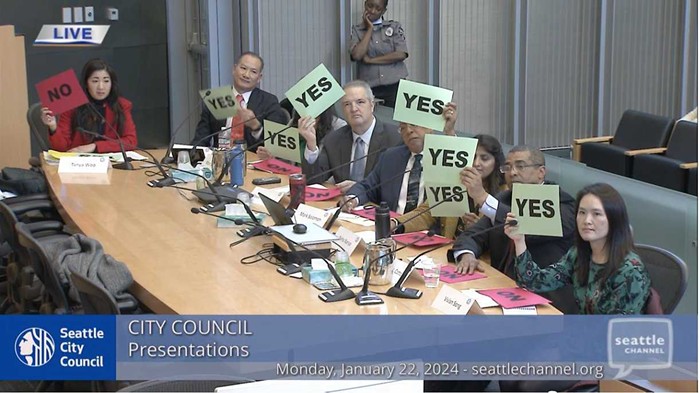One of the group's leaders, Franklin High School senior Adrian Boscolo-Hightower called the crowd over to a grassy slope in front of the building. He kicked off a long but energetic rally, where a dozen youth speakers listed their gripes against the school district: "euro-centric" curriculum, military recruiters who target students of color, racist mascots, and school staff without adequate "undoing racism" training.
The lefty youth were joined by parents from the South End's Save Our Schools Coalition, who have a more basic problem with the school district: They say South End parents are left out of decisions that affect their kids. Those concerns prompted a student walk-out last week ["Class Dismissed," Amy Jenniges, May 30].
The rally, which accommodated both the fed-up parents and the idealistic teens, swelled to 150 people by 7:00 p.m., when the school board started its meeting inside the building.
Kids and parents alike picked up their homemade picket signs and started walking in a circle in front of the main entrance, chanting, "Our schools, our choice." The group planned to go into the meeting just after seven o'clock.
But the door was locked. "They didn't let us in," says Boscolo-Hightower.
Several Seattle police officers blocked the main entrance with bikes. A district security official with a clipboard stood behind the officers, checking off names as she let select people in. The protesters were not on her list, and weren't allowed in, despite the fact that the meeting was public. By the end of the night, only a few protesters made it into the meeting--those who did were on a prearranged list of speakers.
The district's decision to bar protesters from attending a public meeting is questionable. Their rationale--first, that the room was full, and second, that they feared protesters would disrupt the meeting--shut out both the kids and parents. That's disconcerting, and calls into question whether the district violated the state's 1971 Open Public Meetings Act.
The district's first reason for keeping people outside was the fire code: When South Seattle parent Gil Goins approached the police barricade and asked to enter, he was told the room was full. There is only space for about 250 people, district reps told him. Goins--a black man who's been outspoken on South End issues and helped organize the May 29 walk-out--was scheduled to speak, and was told he might be able to get in when it was his turn.
This isn't the first time a school board meeting has been completely full. In fact, a meeting last month was also partially closed down due to a packed room. But at that meeting (protesting school bus drivers were outside), the district acted appropriately. Protesters were allowed in as space became available.
"At [the bus drivers'] meeting, people would leave the meeting and they'd let more people in," recalls Kirk Stephenson, president of the bus drivers' union.
That wasn't the case this time. When space became available on Wednesday night--groups of middle-school athletes who attended the meeting to receive athletic awards left early with their massive trophies--protesters still weren't allowed in.
The district's reason for keeping protesters out had evidently changed. Now, an hour into the board meeting, district officials said they were fearful of the protesters.
"They were assuming right away that we would go in there and be unruly," says Boscolo-Hightower.
As it turns out, the district did have reason to assume the protesters would be disruptive. Half an hour into the meeting, about 30 kids and parents snuck in through an unlocked side door that led directly into the meeting room. They chanted and sang, even after school board member Steve Brown asked them to quiet down. Brown says the protesters had a bullhorn, and were talking and jumping around. He asked them to quiet down. When they didn't, they were escorted outside.
While it was legit to escort those disruptive protesters outside--the Open Public Meetings Act allows for such actions--the district took it a step further, and closed the doors for the night, keeping the rest of the protesters out even as the room emptied. According to school district spokesperson Lynn Steinberg, it was either keep the protesters out entirely, or end the meeting and reconvene somewhere else. Reconvening elsewhere would have excluded the people already inside the meeting, which the district didn't want to do.
"We had a right to go further than we did," she says. "But we chose the least restrictive of those actions. We wanted to respect the rights of all those who signed up to speak."
Ultimately, both district decisions--limiting the flow of people due to space, and then closing the meeting to outside protesters--may butt up against the state's Open Public Meetings Act.
I wasn't allowed into the meeting, so I'll just have to believe the district when they said at the outset that things were too cramped to let protesters in. The district did allow a KOMO TV news reporter and photographer in later--other TV reporters didn't try to gain entry.
Meanwhile, keeping out protesters who had yet to disrupt the meeting--on the assumption that they might disrupt the meeting--is possibly a violation of the law. And there was little indication that the people waiting outside would be disruptive. Goins, who did most of the negotiating with district officials, promised they would leave signs outside and be quiet in the meeting room.
Steinberg, however, says letting them in simply wasn't an option for the district on Wednesday.
"You're saying we should just keep opening the door?" she asked incredulously.
Yes, that's exactly what I'm saying. And Attorney General's Office spokesperson Cheryl Reid agrees, pointing to the law: "If these people were not disruptive and there was plenty of space, then they should have been allowed in," she says.


















